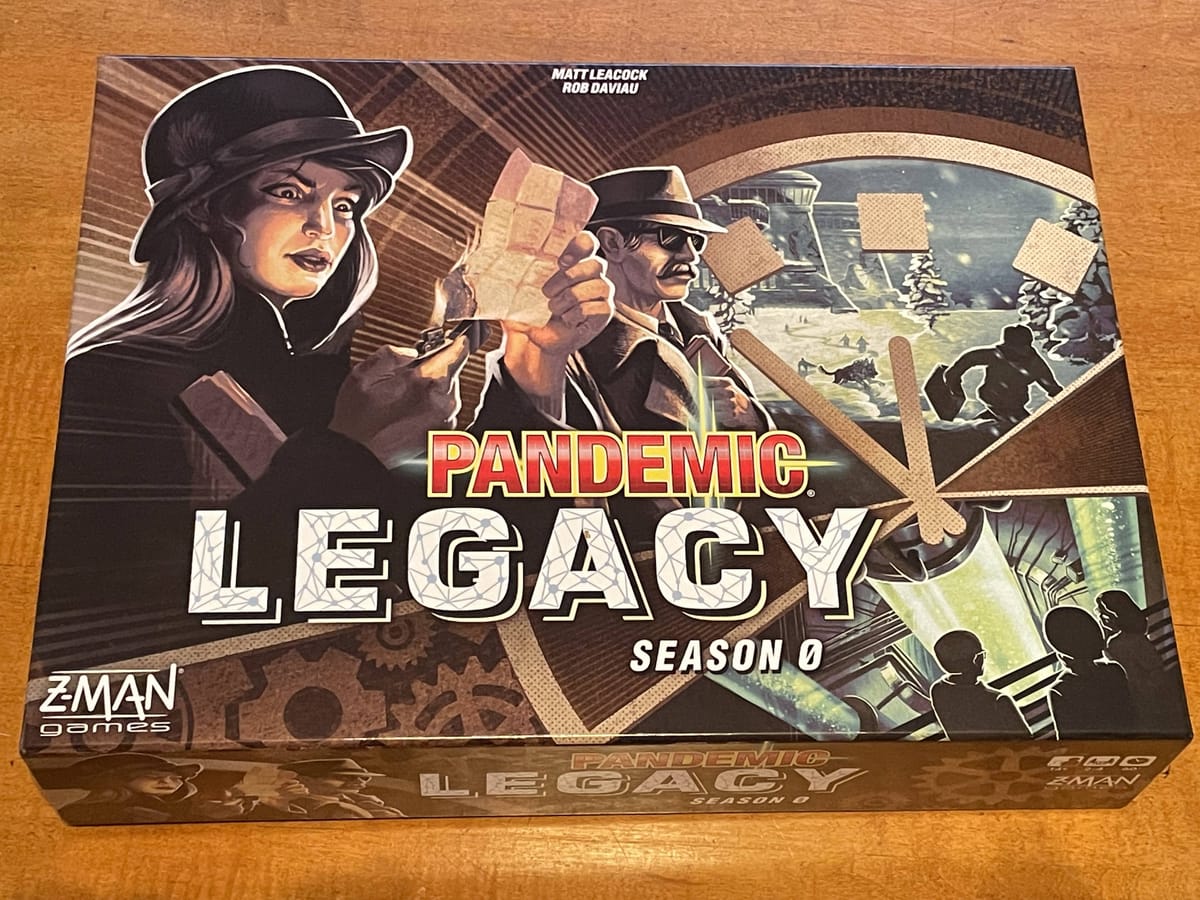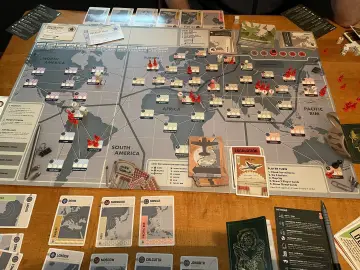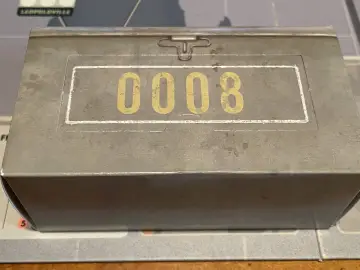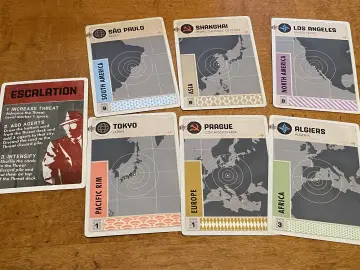
Pandemic has been in my collection for a long time. I still have the original black box version that contained wooden cubes. Since it was cooperative, friends were less apprehensive about trying it out since we’d all be playing to reach the same goal. Some were blown away by the fact that we were playing against the game instead of each other.
When I heard about Pandemic Legacy I was intrigued by the idea, but I wasn’t sure that I’d be able to play it all the way through. I barely get a chance to play through the games that I already own. Playing the same game multiple times with slight changes with the same group just didn’t seem possible, so I never played Pandemic Legacy Season 1 or 2. However, the chance to play Pandemic Legacy Season 0 was offered, so I got a group of friends together and we decided to make a run of it.
Normally I wouldn’t mention the group I played with, but I think it is worth noting since I played Season 0 with the same group through the entire campaign. We even sat in the same configuration around the board each time. I am the gamer with the most experience with designer board games. One friend has played a few board games with me but has more experience with RPGs going all the way back to AD&D and Spell Jammer. The other friend had played commercial board games as a kid but really hasn’t had much experience with hobby board games. He still hasn’t played Ticket to Ride or Carcassonne.
Since this is a Legacy game, I will be covering the basics and avoiding spoilers the best I can. The items I cover can be seen on the game’s website or from opening the box for the first time. Any mentions of events later in the game will be kept as generic as possible.
Season 0 is set in 1962 during the Cold War. Your enemy isn’t a disease, but the Russians. Rumors swirl that they have been working on a new bioweapon. You play as CIA Operatives recruited for your medical expertise to try to uncover this diabolical plot. You’ll use aliases, actions, and a little bit of luck to complete objectives and move the story forward. Each game covers a part of a month in chronological order.
When first opening up Season 0 you’ll see the game board. Each location has an affiliation and region. Cities can have one of three affiliations: Allied, Neutral, or Soviet. The affiliation of those cities determines how they can be interacted with in multiple ways, like how easy or difficult it is to travel to them, assembling teams, and how much surveillance it starts out with. For example, Allied cities can be traveled to if you have their card in your hand. You won’t need to discard the card after traveling though. Neutral cities can be traveled to by discarding their card. Soviet cities can only be travelled to directly by discarding the card of the current city you are in.

Instead of getting specific roles, Season 0 comes with four Passports. In these Passports you’ll create your agent’s identity including disguises and assets which are your special abilities. Each affiliation will have their own assets and liabilities, although you only have access to the Allied agent when you start. Having these Passports makes it feel like you are agents more than just having a player sheet in front of you.
Each game starts out with exposition from the Legacy Deck. You’ll get a bit of backstory about why you are given your objectives and possibly some cards that can help you during the next mission. Sometimes you’ll be directed to open one of the boxes during these as well. The boxes might introduce new abilities or new game mechanics. Each one was a surprise, sometimes pleasant and sometimes not.
After that the objectives come about. Sometimes you are told exactly what city you need to go to satisfy the objective, while other times it will get chosen randomly by taking all the cities of a specific region from the player deck and a specific number of those cards are placed under the objective card. Even though you might be playing the same objectives each month, these objectives ensure that your experience will be different from other groups.
Once the objectives have been set up, agents get placed on the board by drawing cards from the Threat Deck. Next, everyone gets a hand of cards from the Player Deck and then the Escalation cards get seeded throughout the rest of the Player Deck. Then everyone selects a character and puts their pawn in Washington. While you theoretically could play Season 0 with different players or change which roles you play each time, our group used the same character and roles each time. We seemed to get into a rhythm with how our characters could best work to accomplish each objective.
During your turn, you first check for surveillance on the city you are in. Every city has a surveillance level of zero to three. If you start in a city with a level of at least one you have to scratch off a number of cover spots in the Passport equal to the level. It might not do anything, or it could cause you to have to discard a card or gain a liability for that alias. In a worst case scenario your character for that affiliation is burned and those abilities can’t be used anymore. If you have a safehouse at that location you can ignore surveillance in that city. While this offered tension in deciding where we went to and how we ended our turn, we did spread out our safehouses well enough that it didn’t seem to be an issue. Also, sometimes when we scratched off cover spots we couldn’t tell if the spot was blank or if we scratched through the paper of the Passports.

Next the player gets four actions. These can be moving to different cities, determining an unknown target city, or creating a team. Most of your special abilities will be performed as an action as well. As you progress through the game you’ll gain more abilities for every player to perform, but typically only certain abilities will be useful during each month.
A new phase that I haven’t encountered before is the Mop Up phase. During this time all teams on the board can remove all the agents of the city they are in as long as the team and city both have the same affiliation. Creating teams and sending them out to clean up agents proved instrumental in the success in our missions.
After the Mop Up completed, two Player cards were taken from that deck. Often these would be a card with a city on it, but sometimes an Event card with a unique ability would be drawn, such as a card that skips the Threat Deck stage. Occasionally the Escalation cards would come out. At this point the card at the bottom of the Threat Deck is drawn and three agents get placed there. Then the Threat Level gets bumped up and all cards in the Threat Deck discard pile are shuffled and put on top of the Threat Deck. Many times our group wondered if the Escalation cards would get drawn that round, and sometimes the luck of the draw can put you behind the eight ball depending on when those Escalation cards show up. When those Escalation cards came up at the most inopportune times they often got thrown onto the table and a hand could be felt banging the table in disgust.
Finally, a number of cards equal to the Threat Level get drawn from the Threat deck. For each card that gets drawn, an agent is placed there. If three agents are already in a city then an Incident occurs. The bottom card of the Threat deck gets drawn and instructions on the edge of the card are followed. It might mean that a safehouse in a specific region gets taken away or agents in specific regions get moved back to Washington. Most of the time these didn’t affect us, but they could have definitely caused a huge cramp in our plans.

The best outcome for each month is to complete all the objectives. That is considered Succeeding. If one objective fails, your team is considered Adequate. If your team achieves either of these statuses then you move on to the next month. If your team fails two or more objectives you are considered Failing. You may be told to try to complete the unsuccessful objectives again, or you might get new objectives because of the fact that you failed the first time. You’ll never play the same month more than twice. Agents need to move on from their mistakes quickly because time is of the essence.
After you’ve been given your evaluation, you add surveillance to any cities with an Incident token, up to a max of three. Then you look at the Legacy Deck to see if you have any new instructions before moving onto the next month. Next you get a budget of the number of players in your group, and an additional unit if you successfully completed all objectives. These let you gain assets for your agent, build permanent safehouses, set up counter surveillance in cities, and more. You can’t save any of this budget, so you might as well spend it while you have it. Choosing the right way to spend your money can make a huge difference in how successful you are later in the game.
Pandemic Legacy Season 0 is like an onion. Every month a new layer gets pulled away. New assets and actions become available. New game mechanics get introduced. Sometimes new hurdles get in your way that will make you want to cry. Several surprises came up during the game that I want to mention but would force me to go into spoiler territory. Needless to say the boxes and Event Deck will have you guessing every time you open it. Looking at the rulebook shows how much will be introduced to the game, but you never know when or where those rule stickers will get placed inside it. There was definitely a specific time where we were all blown away by the instructions of the game and felt like we were spies.
It’s difficult to judge the difficulty of Pandemic Legacy Season 0. While my group played a couple of months over, it doesn’t mean that we had an easy time. A prologue game let’s you learn the mechanics without changing the game permanently. We played that twice but failed both times, once in spectacular fashion. Several games we completed the final objective on the last or second to last turn. It wasn’t uncommon for us to count the number of turns we had before the Player deck ran out. Each time it happened we felt a huge sense of accomplishment, as well as heaved a huge sigh of relief. We also learned from our mistakes. In one month we had an objective with multiple cities that we could complete by just resolving one of those cities. While we felt good about resolving the mission and getting an Adequate rating, the ramifications on the board haunted us the rest of the game. It helped us from getting into bigger trouble later. However, I could see how other groups could get into trouble and Season 0 could become an exercise in futility where it feels like your back is up against the wall almost the entire time.

As you’ve probably imagined, the story involved the Russians and their pursuit to take over the world. Several twists and turns occur that are not only affected by how successful you are in the game, but also how your team answers questions. The people you meet and how you respond to your superiors will affect you and others. Some situations feel a bit macabre, but it never went into anything gory or inappropriate. The exposition of the status of your team at the end of the game felt a bit anticlimactic. The punishment or commendations didn’t feel like it had much effect on the final outcome of the story. However, that might have been because of the ending we got.
One of my friends looked online to see how much Season 0 was out of curiosity. He was impressed with the value included in the box. The amount of packaging and components was top notch, and a lot of thought went into how the game itself was packaged. Season 0 kept us playing together for months for about three to four hours a night. The entertainment value for us for all those hours was relatively inexpensive compared to going to a movie or going camping with the family for a weekend. I will admit that there were times when I wanted to play something else on those nights, but the other two couldn’t wait to find out what was coming next, insidious as it might be. I was glad that the final month could only be played once, as it felt completing it was a do or die scenario.
Pandemic Legacy: Season 0
Excellent
Ultimately our group was successful, and the Russian vodka my friend bought to commemorate us finishing the game was shared amongst us. We all had a good time with it, and the negatives on the whole were minor. I'm glad that we completed Pandemic Legacy Season 0, but now that we are finished I'm not sure what to do with it since we can't replay it again. I think I'll hang onto it for a while though, just to remember the fun times I was able to share with my friends. While I can't say how it compares to Season 1 or 2, I have to say that I was thoroughly entertained by Season 0.
Pros
- Incredible value
- Lots of twist and turns in story and gameplay
- Game adjusts difficulty depending on how successful you are
- No need to play the previous Pandemic Legacy games
Cons
- What do you do with it when you are finished playing the last game?
- The cover scratch offs sometimes had issues
- Could get frustrating if your team is constantly losing
- Feels like it needs to be played with the same people the whole time